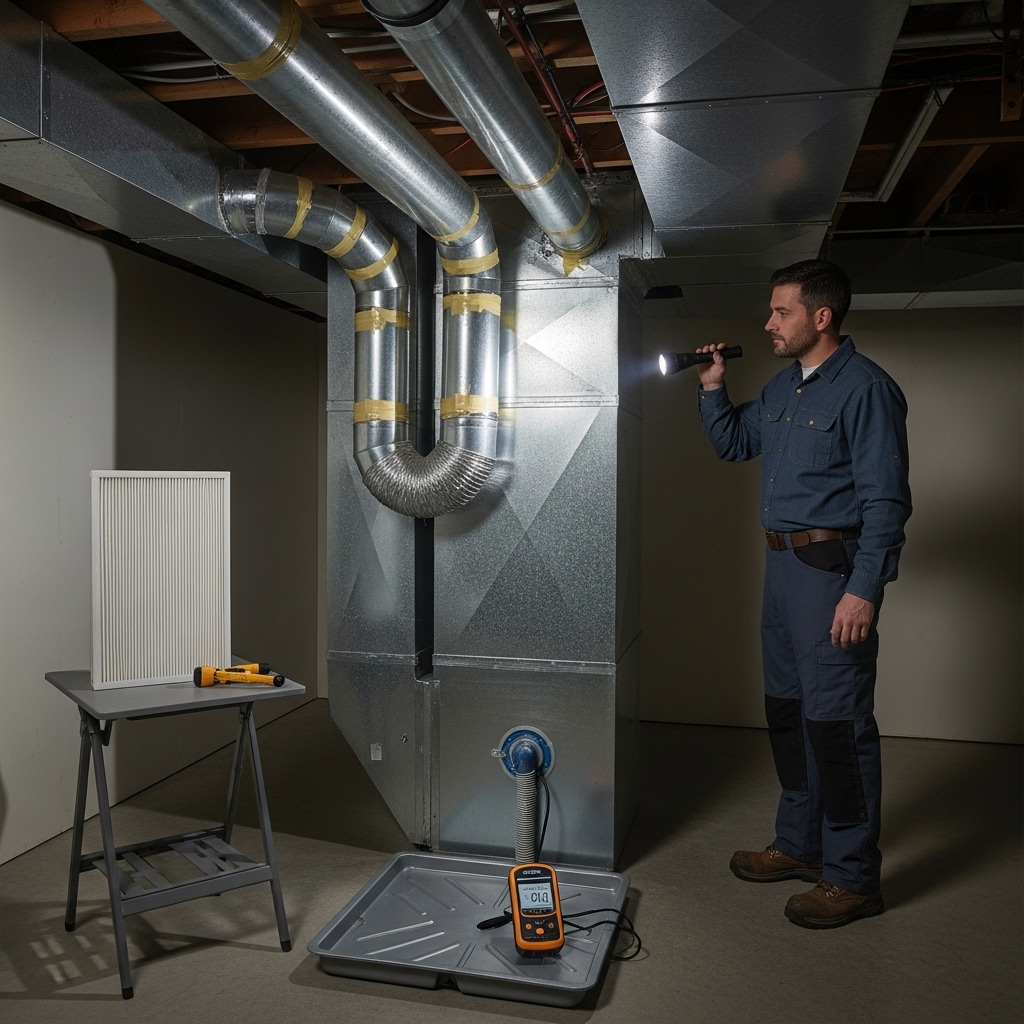Even with regular maintenance, New Jersey homeowners can encounter dust, odors, or airflow issues that hint at duct problems. Seasonal pollen, coastal humidity, and aging duct materials can all contribute. If you are unsure whether to book air duct cleaning or to investigate other causes first, use this troubleshooting guide to pinpoint issues and decide on the right next steps.
Step 1: Confirm Filter Fit, Rating, and Change Cadence
Start with the filter. An improperly sized or installed filter allows bypass dust to enter returns and accumulate in ducts. Choose a filter with a rating your blower can handle and replace it on schedule. If filters collapse or bow inward, a higher-quality frame or a better-fitting filter may be needed.
Step 2: Inspect Return-Side Leaks
Unsealed return ducts can pull dusty air from attics, basements, or garages. Look for gaps around the air handler, missing screws on return grills, or disconnected flex duct collars. Sealing leaks reduces dust entry and improves system efficiency.
Step 3: Check for Moisture Sources
Musty or sour odors often point to moisture. Examine condensate lines, drain pans, and nearby plumbing. Address roof or foundation leaks, and manage humidity with dehumidifiers if needed. Cleaning without controlling moisture provides short-lived results.
Step 4: Consider Recent Renovations or Lifestyle Changes
Drywall sanding, flooring cuts, and increased pet shedding can rapidly load filters and duct surfaces. After renovations, a thorough cleaning plus careful vacuuming of registers can help reset the system.
Step 5: Evaluate Airflow and Room Balance
Uneven airflow may indicate restrictions, closed or blocked registers, or crushed flex duct. Ensure furniture or curtains are not blocking vents. If some rooms remain under-supplied, balancing or duct repairs may be necessary alongside cleaning.
Step 6: Look for Pest Indicators
Insects or rodents can introduce debris and odors. If droppings or nesting materials are discovered, exclusion and sanitation steps are required before or during any duct cleaning.
Step 7: Decide Between Targeted Cleaning and Whole-System Service
If only one area shows issues—like a return near a renovation zone—targeted work might suffice. Widespread dust or odors suggest whole-system service, including returns, supplies, and accessible components.
Step 8: Understand Proper Cleaning Methods
Effective cleaning uses negative pressure and mechanical agitation for source removal. Registers are sealed to maintain suction, and access points are created, then resealed. Ask providers to outline their workflow for professional air duct cleaning and how they adapt to different duct materials.
Step 9: Address Odors Strategically
Identify the source first—moisture, pests, or contaminated insulation. Sanitation is considered only after debris removal and moisture control. Products used should be suitable for HVAC systems and applied according to label instructions.
Step 10: Post-Clean Verification
- Install a fresh, properly rated filter.
- Check that all registers are reinstalled and fully open.
- Review before-and-after photos of key areas.
- Monitor dust levels and airflow over the next couple of weeks.
Common Issues and How to Solve Them
- Persistent dust despite cleaning: Reassess return leaks, filter fit, and household dust sources such as older carpeting or attic bypasses.
- Musty odors after rain: Inspect for roof leaks, poor insulation around ducts, or water intrusion near the air handler.
- Whistling vents: May indicate high filter resistance or partially closed dampers; adjust and retest.
- Allergy flare-ups: Consider improving filtration, sealing returns, and running the fan on low to increase filtration during peak pollen.
- Visible debris at one register: That branch may still be restricted; targeted re-cleaning or repair can help.
When to Call a Professional
If you find moisture, pests, or damaged duct materials, it is time to consult a qualified technician. The right provider will explain how they protect your home, document results, and recommend preventive steps to reduce recurrence.
Preventive Practices for New Jersey Homes
- Keep outdoor intakes clear of leaves and lint.
- Use entryway mats and regular vacuuming to reduce tracked-in dust.
- Seal attic and basement bypasses that allow unfiltered air into returns.
- Maintain gutters and grading to keep water away from the foundation.
- Schedule routine HVAC inspections to catch issues early.
Frequently Asked Questions
Q: How do I know if I need cleaning or repairs? A: If dust is widespread and filters load rapidly, cleaning helps; if airflow is uneven or you see damaged ducts, repairs or balancing may be required as well.
Q: Can cleaning fix odors? A: Only when the source is controlled. Moisture, pest remnants, or contaminated insulation must be addressed to prevent odor return.
Q: How soon will I notice changes? A: Many homeowners see reduced surface dust and fresher air within days; airflow improvements are often immediate.
Q: Will cleaning increase energy efficiency? A: Removing restrictions can help the blower move air more easily, supporting better performance.
Q: Is there a best season to troubleshoot and clean? A: Spring and fall are convenient, but act whenever you notice signs to prevent escalation.
Restore Clean, Comfortable Airflow
By following these troubleshooting steps, you can separate quick fixes from deeper issues and choose the right pathway—repairs, better filtration, or comprehensive cleaning. When you are ready to restore clean circulation and peace of mind, schedule a trusted air duct cleaning service that documents results and helps protect your New Jersey home for seasons to come.

